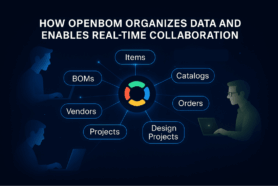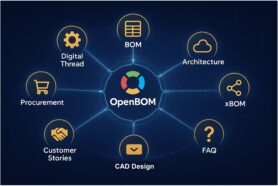
In the space of modern industrial operations and manufacturing, the quest for efficient CAD data management, streamlined BOM management, and seamless communication with contractors and suppliers has become increasingly imperative. While many companies perceive adopting Product Lifecycle Management (PLM) software as the silver bullet, the reality is often far from simple.
In this article, I will explore the crucial preliminary steps necessary to fortify data management before diving into the world of PLM solutions. Drawing from our experiences and insights gained from grappling with data management challenges, we present a strategic approach to lay a robust foundation for effective PLM implementation.
Focus on Data and Processes:
Before rushing to embrace sophisticated computer software, it’s paramount to conduct a careful examination of existing data and processes. As the adage goes, “garbage in, garbage out” – a chaotic data landscape pre-implementation will likely result in a digital replication of disorder. If you have a mess, don’t bring computers. Otherwise, you will end up with a computerized mess. Therefore, forward-thinking entails first comprehending your data infrastructure and delineating information flows.
Begin by checking how data is currently stored and managed within your organization. Identify the primary repositories and validate their reliability and accuracy. Simultaneously, map out the pathways through which information traverses across various departments, tools, and stakeholders. Understanding these fundamental elements lays the groundwork for effective data governance and process optimization.
Establish Data Integrity and Single Source of Truth:
Central to effective data management is the establishment of a single source of truth. This entails aggregating all information assets and defining authoritative sources for critical data elements. For instance, clarify where Part Numbers are defined and stored, and establish protocols for managing Item Master information. Moreover, carefully document the lifecycle of files, where data is defined and edited, including version control mechanisms to track modifications accurately.
By combining data with integrity and establishing clear ownership and governance of the data, organizations can mitigate the risks of data fragmentation and inconsistency.
Streamline Information Flow:
The efficacy of PLM implementation hinges on the seamless flow of information across organizational boundaries. An understanding of information flow dynamics is pivotal to optimizing product lifecycle management processes. Consider the journey of data from its inception, through design iterations, to final product release and beyond.
Map out the complex web of data movements, including processes for item master creation, BOM compilation, and integration with ERP systems. Identifying bottlenecks and inefficiencies enables targeted interventions to enhance collaboration and agility.
Optimize Data and Information Flow:
After you’ve done data analysis and clarification of the information flow dynamics, organizations can now explore suitable PLM systems and customization options. While leveraging multiple systems for distinct purposes is possible, interoperability and data coherence must remain your critical considerations.
Avoid the temptation to replicate existing manual process flow. Instead, aim to rationalize workflows by eliminating redundant tasks and automating routine operations. By doing so, organizations can unlock efficiencies and minimize the risk of data silos and discrepancies.
Conclusion:
The journey toward effective PLM implementation starts with a strong commitment to data organization and information flow optimization. By carefully analyzing existing data assets, establishing data integrity frameworks, and streamlining information flows, organizations can build their data management foundations.
The goal to achieve PLM excellence requires a strategic approach that goes beyond the mere adoption of software solutions. It demands a holistic understanding of data dynamics and a commitment to establish operational efficiency. By following the steps I outlined in this article, organizations can navigate the complexities of modern data management and pave the way for transformative PLM experience.
To have a tool that can help you gradually in the process is extremely important. OpenBOM gives you a free and instant trial to start modeling your data environment, use the integration with existing tools (eg. CAD), and direct spreadsheet integration. All together, it will help you to build your steps toward data management excellence and process optimization.
REGISTER FOR FREE and explore how OpenBOM can help you today.
Best, Oleg
Join our newsletter to receive a weekly portion of news, articles, and tips about OpenBOM and our community.










